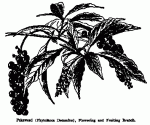Phytolacca Decandra L.
 SYNONYM—Phytolacca Americana (L). (Phytolacca Americana L. by right of priority should be accepted but P. Decandra L. is used in conformity with the Pharmacopoeia.)
SYNONYM—Phytolacca Americana (L). (Phytolacca Americana L. by right of priority should be accepted but P. Decandra L. is used in conformity with the Pharmacopoeia.)
DRUG NAME—Phytolacca.
OTHER COMMON NAMES—Poke, pigeon-berry, garget, scoke, pocan, coakum, Virginia poke, inkberry, red inkberry, American nightshade, cancer-jalap, redweed.
HABITAT AND RANGE—Pokeweed, a common, familiar, native weed, is found in rich, moist soil along fence rows, fields, and uncultivated land from the New England States to Minnesota south to Florida and Texas.
DESCRIPTION OF PLANT—In Europe, where pokeweed has become naturalized from his country, it is regarded as an ornamental garden plant, and, indeed, it is very showy and attractive with its reddish purple stems, rich green foliage, and clusters of white flowers and dark-purple berries.
The stout, smooth stems, arising from a very large perennial root, attain a height of from 3 to 9 feet and are erect and branched, green at first, then reddish. If a piece of the stem is examined, the pith will be seen to be divided into diskshaped parts with hollow spaces between them. The smooth leaves are borne on short stems and are about 5 inches long and 2 to 3 inches wide, ovate or ovate oblong, acute at the apex, and the margins entire. The long-stalked clusters of whitish flowers, which appear from July to September are from 3 to 4 inches in length, the flowers numerous and borne on reddish stems. In about two months the berries will have matured and assumed a rich dark-purple color. These smooth and shining purple berries are globular, flattened at both ends, and contain black seeds embedded in a rich crimson juice. This plant belongs to the pokeweed family (Phytolaccaceae).
DESCRIPTION OF ROOT—Pokeweed has a very thick, long, fleshy root, conical in shape and branches very much resembling that of horseradish and poisonous. In commerce it usually occurs in transverse or lengthwise slices, the outside a yellowish brown and finely wrinkled lengthwise and thickly encircled with lighter colored ridges. It breaks with a fibrous fracture and is yellowish gray within. The transverse slices show many concentric rings. There is a slight odor and the taste is sweetish and acrid. The root when powdered causes sneezing.
COLLECTION, PRICES AND USES—The root of the Pokeweed, which is official in the United States Pharmacopoeia, is collected in the latter part of autumn, thoroughly cleaned, cut into a transverse or lengthwise slices, and carefully dried. It brings from 2 ½ to 4 cents a pound.
The root is used for its alterative properties in treating various diseases of the skin and blood, and in certain cases in relieving pain and allaying inflammation. It also acts upon the bowels and causes vomiting.
The berries when fully matured are also used in medicine.
The young and tender shoots of the pokeweed are eaten in spring, like asparagus, but bad results may follow if they are not thoroughly cooked or if they are cut too close to the root.
Ginseng and Other Medicinal Plants, 1936, was written by A. R. Harding.

